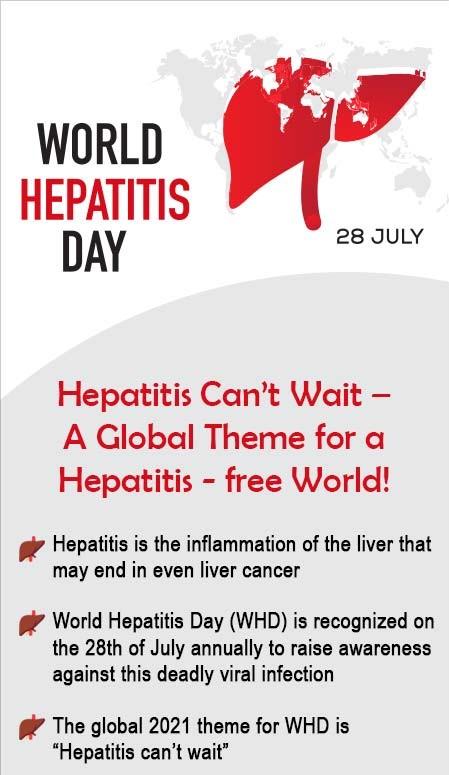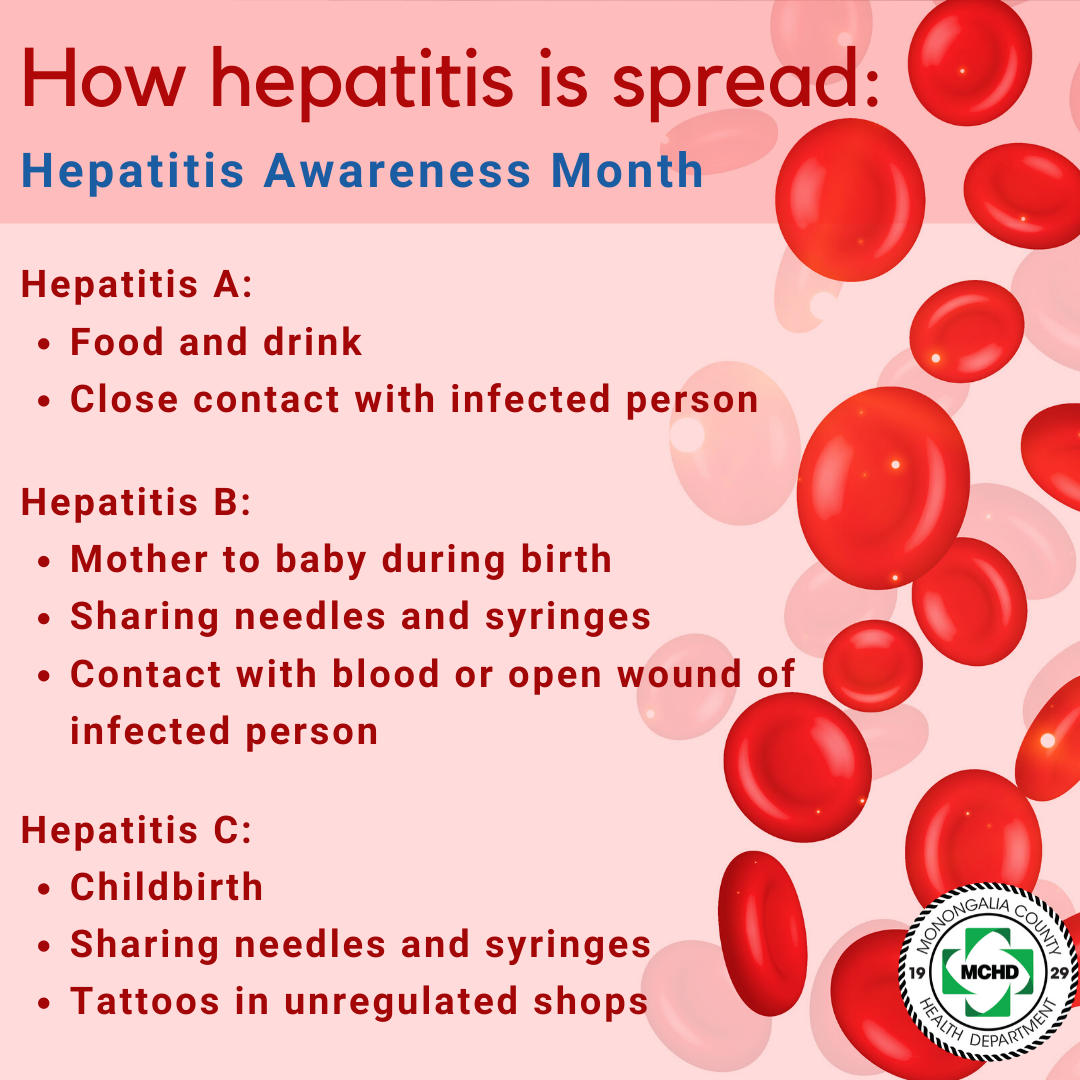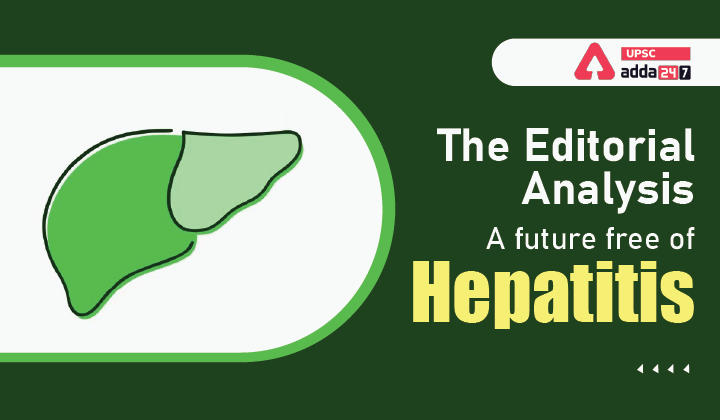Table of Contents
World Hepatitis Day- A Future Free of Hepatitis- Relevance for UPSC Exam
General Studies II- Issues relating to development and management of Social Sector/Services relating to Health, Education, Human Resources.

In News
World Hepatitis Day is observed each year on 28th July to enhance awareness of viral hepatitis and this year the World Health Organization (WHO) is highlighting the need to bring hepatitis care closer to the people in need
Hepatitis can be life threatening unless it is detected in a timely manner and there is good treatment available. On World Hepatitis Day, therefore, there is a push for more global awareness about the infection, its diagnosis, and how to prevent it, among other things.
 What is Hepatitis?
What is Hepatitis?
- Hepatitis refers to inflammation of the liver —the irritation or swelling of the liver cells from any cause.
- It can be acute -inflammation of the liver that presents with sickness — jaundice, fever, vomiting or chronic -inflammation of the liver that lasts more than six months, but essentially showing no symptoms.
- Can cause permanent damage to the liver (cirrhosis) and even liver cancer
Types of Hepatitis
- Hepatitis A is a contagious liver infection that is caused by the hepatitis A virus. People with this type of hepatitis can feel sick for weeks or months, but usually recover completely with no liver damage.
- Hepatitis B can be more severe than hepatitis A. For some people, the infection only lasts for a few weeks; this is acute hepatitis B. Those who develop chronic hepatitis B will have a lifelong infection that can cause liver cancer, cirrhosis or death.
- The third type, Hepatitis C, is spread when infected blood enters the body of an uninfected person. This can happen when sharing needles, being born to an infected mother or tattoos from unregulated places.
- Hepatitis D is an infection that can only occur in people already infected with hepatitis B. Hepatitis D can be acute or chronic. The hepatitis D virus combined with hepatitis B can cause liver disease to progress faster than hepatitis B alone. There is no vaccine, but it can be prevented by the hepatitis B vaccine in people who are not already infected.
- Hepatitis E is not common in developed countries. The virus can be spread by contaminated water, undercooked pork or deer meat and shellfish. It is often less severe than other strains of the virus; most recover completely and are very unlikely to progress from acute to chronic infection Hepatitis E is not common in developed countries. The virus can be spread by contaminated water, undercooked pork or deer meat and shellfish. It is often less severe than other strains of the virus; most recover completely and are very unlikely to progress from acute to chronic infection
Causes
- Caused by a group of viruses known as the Hepatotropic(liver directed) viruses, including A, B, C, D and E.
- Other viruses such as Varicellavirus that causes chicken pox and SARS-CoV-2 causing Covid-19 may injure the liver too.
- Drugs and alcohol overdose, fat buildup in the liver(fatty liver hepatitis) or an autoimmune process in which a person’s body makes antibodies that attack the liver (autoimmune hepatitis).
Spread
- Viral hepatitis A and E are spread by contaminated water or exposure to the faecal matter of an infected person.
- Hepatitis B, C and D are transmitted through blood and body fluids. Unprotected sex, sharing needles and grooming accessories such as nail cutters, razors etc.
- Can be transmitted from mother to child.

Prevention
- Ensure clean and safe drinking water.
- Avoid sharing a razor, nail cutter, needles etc.
- Avoid unprotected sex.
- Every newborn child should be vaccinated against these viruses.
- Those with liver disease should especially get vaccinated as viral hepatitis may be severe in them.
Treatment
- Hepatitis A and E are self-limiting diseases a and require no specific antiviral medications.
- For Hepatitis B and C, effective medications are available.
Government Initiatives
National Viral Hepatitis Control Programme
AIM
- Combat hepatitis and achieve country wide elimination of Hepatitis C by 2030
- Achieve significant reduction in the infected population, morbidity and mortality associated with Hepatitis B and C viz. Cirrhosis and Hepato-cellular carcinoma (liver cancer)
- Reduce the risk, morbidity and mortality due to Hepatitis A and E.
Objectives
- Enhance community awareness on hepatitis and lay stress on preventive measures among general population especially high-risk groups and in hotspots.
- Provide early diagnosis and management of viral hepatitis at all levels of healthcare
- Develop standard diagnostic and treatment protocols for management of viral hepatitis and its complications.
- Strengthen the existing infrastructure facilities, build capacities of existing human resource and raise additional human resources, where required, for providing comprehensive services for management of viral hepatitis and its complications in all districts of the country.
- Develop linkages with the existing National programmes towards awareness, prevention, diagnosis and treatment for viral hepatitis.
- Develop a web-based “Viral Hepatitis Information and Management System” to maintain a registry of persons affected with viral hepatitis and its sequelae
Components
- Preventive component: This remains the cornerstone of the NVHCP. It will include
- Awareness generation
- Immunization of Hepatitis B (birth dose, high risk groups, health care workers)
- Safety of blood and blood products
- Injection safety, safe socio-cultural practices
- Safe drinking water, hygiene and sanitary toilets
- Diagnosis and Treatment:
- Screening of pregnant women for HBsAg to be done in areas where institutional deliveries are < 80% to ensure their referral for institutional delivery for birth dose Hepatitis B vaccination.
- Free screening, diagnosis and treatment for both hepatitis B and C would be made available at all levels of health care in a phased manner.
- Provision of linkages, including with private sector and not for profit institutions,for diagnosis and treatment.
- Engagement with community/peer support to enhance and ensure adherence to treatment and demand generation.
- Monitoring and Evaluation, Surveillance and Research Effective linkages to the surveillance system would be established and operational research would be undertaken through Department of Health Research (DHR). Standardised M&E framework would be developed and an online web based system established.
- Training and capacity Building: This would be a continuous process and will be supported by NCDC, ILBS and state tertiary care institutes and coordinated by NVHCP. The hepatitis induction and update programs for all level of health care workers would be made available using both, the traditional cascade model of training through master trainers and various platforms available for enabling electronic, e-learning and e-courses.



 TSPSC Group 1 Question Paper 2024, Downl...
TSPSC Group 1 Question Paper 2024, Downl...
 TSPSC Group 1 Answer key 2024 Out, Downl...
TSPSC Group 1 Answer key 2024 Out, Downl...
 UPSC Prelims 2024 Question Paper, Downlo...
UPSC Prelims 2024 Question Paper, Downlo...
